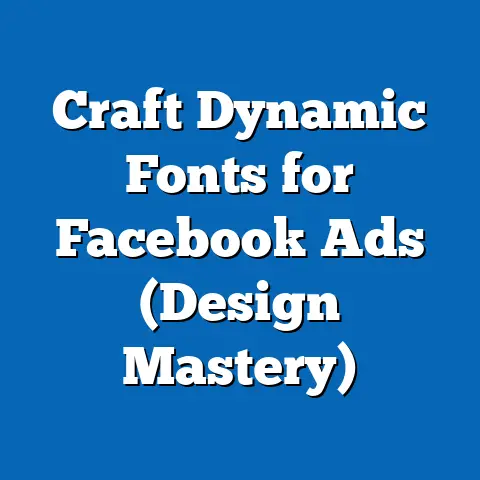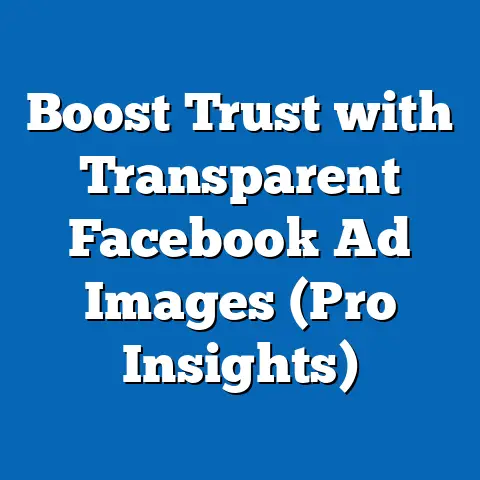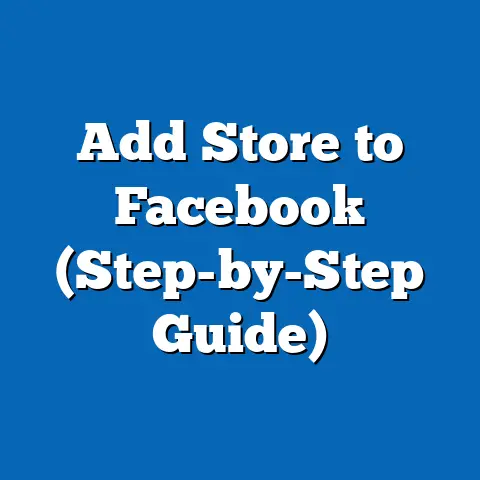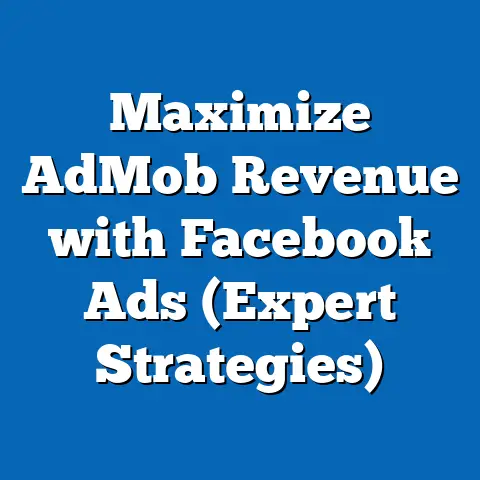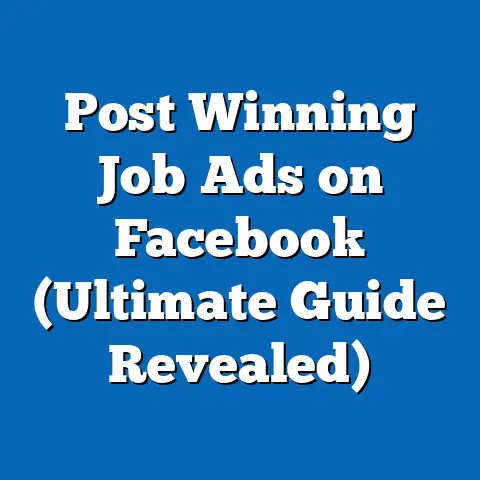Unlock Facebook Ad Boosts (Maximize Reach Today)
The digital marketing landscape is in constant flux. What worked yesterday might not work today, and what’s trending now could be old news tomorrow. This rapid evolution makes it challenging for businesses to stay ahead, particularly in social media advertising. But amidst this dynamic environment, Facebook remains a powerhouse. With billions of active users worldwide, it offers an unparalleled platform for reaching diverse audiences and achieving significant business goals.
I’ve seen firsthand how businesses, big and small, have leveraged Facebook to connect with their target market. From a local bakery boosting a post about their new cupcake flavor to a national retailer running a campaign for their latest product line, the potential is immense. However, simply having a Facebook page isn’t enough. To truly cut through the noise and reach your intended audience, you need a strategic approach. That’s where Facebook Ad Boosts come in.
My goal is to equip you with the knowledge and tools you need to transform your Facebook presence and achieve your business objectives. So, buckle up, and let’s dive into the world of Facebook Ad Boosts!
Section 1: Understanding Facebook Ad Boosts
Let’s start with the basics. What exactly are Facebook Ad Boosts?
What are Facebook Ad Boosts?
Facebook Ad Boosts, often simply called “boosted posts,” are a paid advertising feature that allows you to increase the visibility of your organic Facebook posts. Think of them as a quick and easy way to amplify your message beyond your existing followers. Instead of creating a brand new ad from scratch, you can take a post that’s already performing well and give it a little extra “oomph” to reach more people.
Organic Reach vs. Boosted Posts: Why Boost?
In the early days of Facebook, organic reach – the number of people who see your posts without paid promotion – was significantly higher. Today, however, Facebook’s algorithm prioritizes content from friends and family, meaning that your business page’s organic reach is likely much lower than it used to be.
This is where boosted posts come in. While organic reach is still important for building brand awareness and fostering relationships with your existing audience, it’s often not enough to achieve significant growth. Boosted posts allow you to break through the algorithmic barriers and reach a wider audience that might not otherwise see your content.
Here’s a breakdown of the key differences:
- Organic Reach: Free visibility of your posts to your existing followers and their friends (if they engage with your content).
- Boosted Posts: Paid visibility of your posts to a wider audience, including people who don’t currently follow your page.
Boosting a post allows you to:
- Expand your reach: Reach new potential customers who might be interested in your products or services.
- Increase engagement: Drive more likes, comments, and shares on your posts.
- Drive traffic to your website: Include a link in your boosted post to direct people to your website.
- Generate leads: Run lead generation campaigns directly from your boosted posts.
Think of it this way: organic reach is like planting seeds in your own garden, while boosted posts are like scattering seeds in a wider field, hoping to cultivate new growth.
Types of Posts You Can Boost
Facebook allows you to boost a variety of post types, each with its own advantages:
- Photos: Visual content is highly engaging, making photo posts a great option for boosting brand awareness and showcasing your products or services. I’ve found that behind-the-scenes photos or user-generated content perform particularly well.
- Videos: Video is king on social media. Boosted video posts can capture attention and tell compelling stories, making them ideal for promoting your brand, showcasing product demos, or sharing customer testimonials.
- Links: If your goal is to drive traffic to your website, boosting a link post is the way to go. Make sure to include a compelling headline and description to entice people to click through.
- Events: Promoting an upcoming event? Boosting an event post can help you reach a wider audience and increase attendance.
- Offers: Running a special promotion? Boosting an offer post can help you attract new customers and drive sales.
The best type of post to boost will depend on your specific goals and target audience. Experiment with different formats to see what works best for you.
Real-World Examples of Successful Ad Boosts
Let’s look at some examples of how businesses have successfully used Facebook Ad Boosts:
- Local Restaurant: A local restaurant boosted a post featuring a mouthwatering photo of their new menu item. By targeting local residents interested in food and dining, they were able to drive a significant increase in reservations.
- E-commerce Store: An e-commerce store boosted a video showcasing their latest product line. By targeting potential customers based on their interests and demographics, they were able to generate a significant increase in website traffic and sales.
- Non-Profit Organization: A non-profit organization boosted a post sharing a heartwarming story about how their organization is making a difference. By targeting people interested in charitable giving, they were able to raise awareness and generate donations.
These are just a few examples, and the possibilities are endless. The key is to create compelling content, target the right audience, and track your results.
The Facebook Algorithm and Boosted Ads
It’s important to understand that even with boosted posts, you’re still working within the framework of the Facebook algorithm. The algorithm determines which content is shown to which users, and it takes into account a variety of factors, including:
- Relevance: How relevant is your content to the user?
- Engagement: How likely is the user to engage with your content?
- Timeliness: How recent is your content?
Boosting a post can help you overcome some of the algorithmic limitations, but it’s not a magic bullet. You still need to create high-quality content that resonates with your target audience.
Key Takeaways:
- Facebook Ad Boosts are a simplified way to amplify your organic content.
- They allow you to reach a wider audience beyond your existing followers.
- You can boost a variety of post types, each with its own advantages.
- Successful ad boosts require compelling content, targeted audiences, and careful tracking.
- The Facebook algorithm still plays a role, so focus on creating high-quality, relevant content.
Next Steps:
- Identify your best-performing organic posts.
- Consider which posts would benefit most from a boost.
- Define your goals for boosting a post (e.g., reach, engagement, traffic).
Section 2: Crafting Compelling Content for Boosted Ads
Now that you understand the basics of Facebook Ad Boosts, let’s talk about content. After all, even the best-targeted ad won’t perform well if the content is boring or irrelevant.
Key Elements of Engaging Content
Creating engaging content is crucial for maximizing the impact of your boosted ads. Here are some key elements to consider:
- High-Quality Visuals: In today’s visually driven world, high-quality visuals are essential. Use clear, crisp images and videos that capture attention and convey your message effectively. I’ve learned that investing in professional photography or videography can make a significant difference in ad performance.
- Compelling Copy: Your ad copy should be concise, engaging, and persuasive. Highlight the benefits of your product or service and use strong calls to action to encourage people to take the next step.
- Clear Call to Action (CTA): Tell people what you want them to do! Use clear and concise CTAs like “Learn More,” “Shop Now,” “Sign Up,” or “Contact Us.” Make sure your CTA is prominent and easy to click.
Tailoring Content for Different Industries
The best content for your boosted ads will depend on your specific industry and target audience. Here are some guidelines for different industries:
- E-commerce: Showcase your products with high-quality images and videos. Highlight special offers and promotions. Use clear CTAs like “Shop Now” or “Add to Cart.”
- Restaurants: Feature mouthwatering photos of your food and drinks. Promote special events and offers. Use clear CTAs like “Order Online” or “Make a Reservation.”
- Real Estate: Showcase your listings with stunning photos and videos. Highlight key features and benefits. Use clear CTAs like “Learn More” or “Contact Us.”
- Services: Focus on the benefits of your services and how you can help your customers solve their problems. Share customer testimonials and case studies. Use clear CTAs like “Get a Free Quote” or “Schedule a Consultation.”
Remember to always tailor your content to your specific target audience. What resonates with one group of people might not resonate with another.
The Power of Storytelling in Ads
Storytelling is a powerful tool that can help you connect with your audience on an emotional level. When you tell a story, you’re not just selling a product or service; you’re selling an experience.
Here are some tips for using storytelling in your ads:
- Focus on the human element: Share stories about real people and how your product or service has helped them.
- Create a sense of empathy: Make your audience feel like they can relate to the characters in your story.
- Use vivid language and imagery: Paint a picture with your words and visuals.
- End with a call to action: Encourage people to take the next step and become part of your story.
I remember working with a local animal shelter that used storytelling to great effect in their Facebook ads. They shared heartwarming stories about rescued animals finding loving homes, and these stories resonated deeply with their target audience. As a result, they saw a significant increase in donations and adoption rates.
A/B Testing Your Ad Content
A/B testing, also known as split testing, is a process of comparing two versions of an ad to see which one performs better. By testing different elements of your ad, such as the headline, image, or CTA, you can identify what resonates most with your audience and optimize your content for better results.
Facebook offers built-in A/B testing tools that make it easy to experiment with different ad variations. I highly recommend using these tools to continuously improve your ad performance.
Key Takeaways:
- Compelling content is essential for maximizing the impact of your boosted ads.
- Focus on high-quality visuals, compelling copy, and clear calls to action.
- Tailor your content to your specific industry and target audience.
- Use storytelling to connect with your audience on an emotional level.
- A/B test your ad content to continuously improve your performance.
Next Steps:
- Brainstorm ideas for compelling content that will resonate with your target audience.
- Create different variations of your ad content to test.
- Set up A/B tests to compare the performance of different ad variations.
Section 3: Targeting the Right Audience
Even the most compelling content will fall flat if it’s not shown to the right people. That’s why audience targeting is so crucial for Facebook Ad Boosts.
The Importance of Audience Targeting
Audience targeting allows you to specify who sees your boosted ads based on their demographics, interests, behaviors, and other factors. By targeting the right audience, you can ensure that your ads are shown to people who are most likely to be interested in your products or services.
Think of it like this: you wouldn’t try to sell snow shovels in Florida, would you? Similarly, you wouldn’t want to show your ads to people who have no interest in what you’re selling.
Audience Segmentation Options
Facebook offers a wide range of audience segmentation options, including:
- Demographics: Target people based on their age, gender, location, education, and other demographic factors.
- Interests: Target people based on their interests, hobbies, and passions.
- Behaviors: Target people based on their online behavior, such as their purchase history, website visits, and app usage.
- Connections: Target people who are connected to your Facebook page or events.
Custom Audiences and Lookalike Audiences
In addition to these basic targeting options, Facebook also offers two powerful features:
- Custom Audiences: Allow you to target people who have already interacted with your business, such as website visitors, email subscribers, or customers. You can upload a list of email addresses or phone numbers to create a custom audience.
- Lookalike Audiences: Allow you to reach new people who are similar to your existing customers. Facebook analyzes your custom audience and identifies people who share similar characteristics, such as demographics, interests, and behaviors.
These features are incredibly valuable for expanding your reach beyond your existing followers and finding new potential customers. I’ve seen businesses achieve significant growth by leveraging custom and lookalike audiences.
Using Facebook Insights for Better Targeting
Facebook Insights provides valuable data about your audience’s demographics, interests, and behaviors. By analyzing this data, you can gain a better understanding of your target audience and refine your targeting strategies.
For example, you might discover that your audience is primarily composed of women aged 25-34 who are interested in fashion and beauty. You can then use this information to target your ads more effectively.
Case Studies: Successful Audience Targeting Strategies
Let’s look at some examples of how businesses have successfully used audience targeting:
- Fitness Studio: A fitness studio targeted local residents interested in health and fitness. They also created a custom audience of people who had visited their website and a lookalike audience based on that custom audience. As a result, they saw a significant increase in new memberships.
- Clothing Boutique: A clothing boutique targeted women aged 18-35 who were interested in fashion and style. They also used Facebook Insights to identify their audience’s favorite brands and targeted people who had liked those brands’ Facebook pages. As a result, they saw a significant increase in online sales.
Key Takeaways:
- Audience targeting is crucial for ensuring that your ads are shown to the right people.
- Facebook offers a wide range of audience segmentation options, including demographics, interests, and behaviors.
- Custom audiences and lookalike audiences are powerful tools for expanding your reach and finding new potential customers.
- Use Facebook Insights to analyze your audience’s demographics, interests, and behaviors.
Next Steps:
- Define your ideal customer profile.
- Identify the demographics, interests, and behaviors of your target audience.
- Create custom audiences and lookalike audiences based on your existing customer data.
- Use Facebook Insights to analyze your audience’s demographics, interests, and behaviors.
Section 4: Budgeting and Scheduling for Maximum Impact
Now that you know how to create compelling content and target the right audience, let’s talk about budgeting and scheduling.
Budgeting Options for Facebook Ad Boosts
Facebook offers two main budgeting options for Ad Boosts:
- Daily Budget: Sets the average amount you’re willing to spend each day. Facebook will try to spend close to your daily budget, but it may fluctuate slightly depending on ad performance.
- Lifetime Budget: Sets the total amount you’re willing to spend over the entire duration of your ad campaign. Facebook will distribute your budget evenly over the scheduled time period.
The best budgeting option for you will depend on your specific goals and budget constraints. If you’re just starting out, I recommend using a daily budget so you can monitor your ad performance and make adjustments as needed.
Determining an Effective Budget
Determining an effective budget can be challenging, especially if you’re new to Facebook advertising. Here are some factors to consider:
- Your Business Goals: What are you trying to achieve with your boosted ads? Are you trying to increase brand awareness, drive traffic to your website, or generate leads?
- Your Target Audience Size: The larger your target audience, the more you’ll need to spend to reach them.
- Your Industry: Some industries are more competitive than others, which means you’ll need to spend more to stand out.
- Your Ad Relevance Score: Facebook assigns each ad a relevance score based on how relevant it is to the target audience. The higher your relevance score, the lower your cost per click (CPC) will be.
As a general rule of thumb, I recommend starting with a small budget and gradually increasing it as you see positive results.
The Importance of Ad Scheduling
Ad scheduling allows you to specify when your ads will be shown to your target audience. This can be particularly useful if you know that your audience is more active at certain times of day or on certain days of the week.
For example, if you’re promoting a restaurant, you might want to schedule your ads to run during lunch and dinner hours. Or, if you’re promoting a weekend event, you might want to schedule your ads to run on Fridays and Saturdays.
Analyzing Peak Times for Optimal Placement
You can use Facebook Insights to analyze your audience’s activity patterns and identify peak times for optimal ad placement. This data can help you schedule your ads for maximum impact.
For example, you might discover that your audience is most active on Facebook between 6 PM and 9 PM on weekdays. You can then schedule your ads to run during those times to reach the largest possible audience.
Monitoring Ad Performance and Adjusting Budgets
It’s important to monitor your ad performance regularly and adjust your budgets accordingly. If you’re seeing positive results, you might want to increase your budget to reach even more people. If you’re not seeing the results you want, you might want to decrease your budget or adjust your targeting strategies.
Key Takeaways:
- Facebook offers daily and lifetime budgeting options for Ad Boosts.
- Determining an effective budget depends on your business goals, target audience size, industry, and ad relevance score.
- Ad scheduling allows you to specify when your ads will be shown to your target audience.
- Use Facebook Insights to analyze your audience’s activity patterns and identify peak times for optimal ad placement.
- Monitor your ad performance regularly and adjust your budgets accordingly.
Next Steps:
- Determine your budget for your Facebook Ad Boosts.
- Schedule your ads to run during peak times for your target audience.
- Monitor your ad performance and adjust your budgets accordingly.
Section 5: Measuring Success and Adjusting Strategies
So, you’ve created compelling content, targeted the right audience, and set your budget and schedule. Now what? It’s time to measure your success and adjust your strategies accordingly.
Key Performance Indicators (KPIs) to Track
To measure the success of your boosted ads, you’ll need to track certain key performance indicators (KPIs). Here are some of the most important KPIs to track:
- Reach: The number of unique people who saw your ad.
- Impressions: The number of times your ad was displayed.
- Engagement: The number of likes, comments, shares, and clicks on your ad.
- Website Traffic: The number of people who clicked on your ad and visited your website.
- Leads: The number of people who filled out a lead generation form after seeing your ad.
- Sales: The number of sales that were generated as a result of your ad.
- Cost Per Click (CPC): The average cost you paid for each click on your ad.
- Cost Per Thousand Impressions (CPM): The average cost you paid for every 1,000 impressions of your ad.
- Return on Ad Spend (ROAS): The amount of revenue you generated for every dollar you spent on advertising.
The specific KPIs you track will depend on your business goals. If you’re trying to increase brand awareness, you’ll want to focus on reach and impressions. If you’re trying to drive traffic to your website, you’ll want to focus on website traffic and CPC. And if you’re trying to generate leads or sales, you’ll want to focus on leads, sales, and ROAS.
Tools for Tracking Ad Performance
Facebook offers a variety of tools for tracking your ad performance, including:
- Facebook Ads Manager: Provides detailed data about your ad performance, including reach, impressions, engagement, website traffic, leads, sales, CPC, CPM, and ROAS.
- Facebook Analytics: Provides insights into your audience’s demographics, interests, and behaviors.
- Third-Party Analytics Tools: There are many third-party analytics tools that can provide even more detailed data about your ad performance.
I recommend using a combination of these tools to get a complete picture of your ad performance.
Interpreting Data and Making Informed Decisions
Once you’ve gathered data about your ad performance, it’s time to interpret that data and make informed decisions. Here are some questions to ask yourself:
- Is my ad reaching the right audience? If not, you may need to adjust your targeting strategies.
- Is my ad generating enough engagement? If not, you may need to improve your ad content.
- Is my ad driving traffic to my website? If not, you may need to improve your ad copy or CTA.
- Is my ad generating leads or sales? If not, you may need to adjust your targeting strategies, ad content, or landing page.
- Is my ad delivering a positive return on investment? If not, you may need to decrease your budget or adjust your strategies.
By analyzing your data and answering these questions, you can identify areas for improvement and optimize your ad performance.
Continuous Learning and Adaptation
The world of Facebook advertising is constantly changing. New features are being released, algorithms are being updated, and audience behaviors are evolving. That’s why it’s so important to embrace continuous learning and adaptation.
Stay up-to-date on the latest trends and best practices in Facebook advertising. Experiment with new features and strategies. And don’t be afraid to fail. The key is to learn from your mistakes and keep improving.
Real-Life Examples of Successful Strategy Pivots
I’ve seen many businesses successfully pivot their Facebook advertising strategies based on data analysis. Here are a couple of examples:
- A local bakery initially targeted a broad audience with their Facebook ads. However, after analyzing their data, they discovered that their ads were performing much better among people who were interested in baking and cooking. They then narrowed their targeting to focus on this specific audience, and as a result, they saw a significant increase in sales.
- An e-commerce store initially used a generic ad campaign to promote their products. However, after analyzing their data, they discovered that their ads were performing much better when they featured specific products. They then created separate ad campaigns for each of their top-selling products, and as a result, they saw a significant increase in revenue.
Key Takeaways:
- Track key performance indicators (KPIs) to measure the success of your boosted ads.
- Use Facebook Ads Manager, Facebook Analytics, and third-party analytics tools to track your ad performance.
- Interpret your data and make informed decisions about your targeting strategies, ad content, and budget.
- Embrace continuous learning and adaptation to stay ahead of the curve.
- Don’t be afraid to pivot your strategies based on data analysis.
Next Steps:
- Set up tracking for your key performance indicators (KPIs).
- Analyze your ad performance data regularly.
- Identify areas for improvement and adjust your strategies accordingly.
- Stay up-to-date on the latest trends and best practices in Facebook advertising.
Conclusion
In today’s competitive marketplace, businesses need every advantage they can get. Facebook Ad Boosts offer a powerful and accessible way to maximize your reach, engage with your target audience, and achieve your business goals.
Throughout this guide, we’ve explored the fundamentals of Facebook Ad Boosts, discussed content strategies, dived into audience targeting, covered budgeting and scheduling, and analyzed how to measure success and adjust your strategies.
Remember these key takeaways:
- Facebook Ad Boosts are a simplified way to amplify your organic content.
- Compelling content is essential for maximizing the impact of your boosted ads.
- Audience targeting is crucial for ensuring that your ads are shown to the right people.
- Budgeting and scheduling can significantly impact your ad performance.
- Measuring your success and adjusting your strategies is essential for continuous improvement.
The future of Facebook advertising is constantly evolving, and it’s important to stay informed about ongoing changes in the platform. By continuously learning, adapting, and experimenting, you can unlock the full potential of Facebook Ad Boosts and drive significant growth for your business.
I encourage you to stay informed about ongoing changes in the platform and adapt your strategies to optimize your advertising efforts continuously. The journey to mastering Facebook Ad Boosts is an ongoing process, but with dedication and a data-driven approach, you can achieve remarkable results. So, go forth, experiment, and unlock the power of Facebook advertising to reach new heights in your business!

